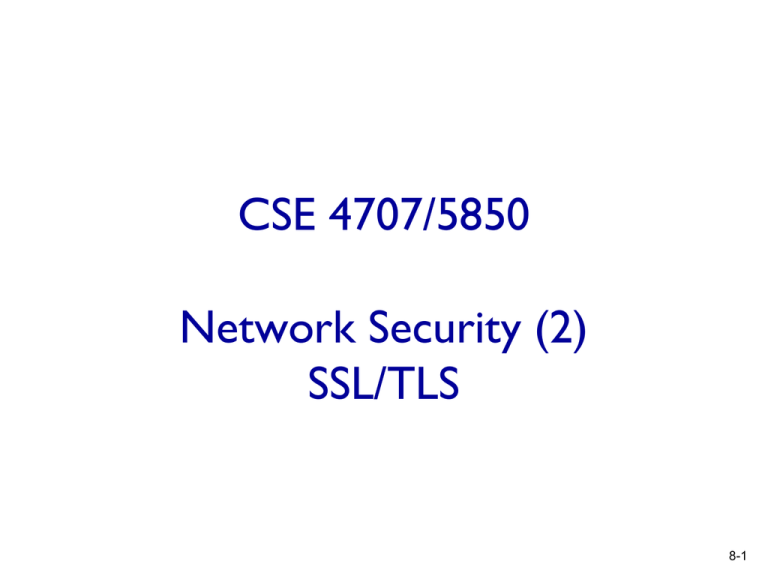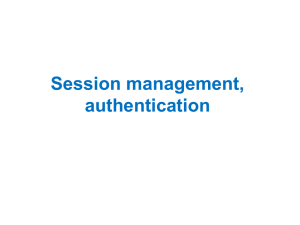CSE 4707/5850 Network Security (2) SSL/TLS 8-1
advertisement

CSE 4707/5850 Network Security (2) SSL/TLS 8-1 Think about Google or YouTube Desired properties Indeed the other side is Google or YouTube server Confidentiality: your query, the video you choose Content from Google or YouTube has not been modified Can you use Kerberos? 8-2 SSL/TLS SSL (Secure Sockets Layer) mechanisms: [Woo 1994], implementation: Netscape SSL Version 3 released in 1996 TLS (Transport Layer Security) Substitute SSL in 1999; standardized by IETF TLS 1.0, RFC 2246, 1999 TLS 1.1, RFC 4346, 2006 TLS 1.2, RFC 5246, 2008 TLS 1.3, working draft as of now 8-3 Goals of SSL/TLS Allows client and server to communicate while preventing eavesdropping and tampering Provide Confidentiality (symmetric key encryption) Message integrity check (through MAC) Authentication (public key crypto) 8-4 Usage of SSL/TLS Implemented in all (major) web browsers Widely used in web browsing, email, instant messaging, voice-over-IP (VoIP), … Major web sites (including Google, YouTube, Facebook) use TLS Available to all applications that use TCP 8-5 SSL/TLS and TCP/IP Application Application SSL/TLS TCP IP normal application TCP IP application with SSL SSL/TLS provides application programming interface (API) to applications C and Java SSL libraries/classes readily available 8-6 TLS Handshake protocol enables authentication and session key establishment Record protocol Uses the secret keys established in the handshake protocol to protect confidentiality, integrity, and authenticity of data exchange between the client and the server 8-7 TLS connection parameters Connection end (client, server) Bulk encryption algorithm MAC algorithm Compression algorithm Master secret (48 bytes) Client random (32 byte) Server random (32 byte) 8-8 Handshake Protocol Overview Runs between a client and a server e.g., client: web browser, server: website Negotiate version of the protocol and the set of cryptographic algorithms to be used Interoperability between different implementations Authenticate server and client (optional) Use digital certificates to learn each other’s public keys and verify each other’s identity Often only the server is authenticated Use public keys to establish a shared secret 8-9 Handshake Protocol Diagram 8-10 ClientHello Random structure (32 bytes) Client Timestamp Random 28 byte string SessionID can be empty / it is used for resuming a previous session Ciphersuite list List of cryptographic algorithms supported by the client Key exchange algorithm, bulk encryption algorithm, MAC algorithm, and PRF Compression list List of compression algorithms 8-11 ClientHello Example 8-12 ServerHello 8-13 ServerHello Example 8-14 Server Certificate server provides its certificate to authenticate its name on the public-key it provides to the client Certificate type MUST be X.509v3, unless explicitly negotiated otherwise 8-15 ClientKeyExchange message Used to set the premaster secret that will allow each side to agree upon the same pre-master secret. By transmitting the RSA-encrypted secret or Diffie-Hellman parameters 8-17 Client Authentication CertificateRequest : server will use this message to request a certificate-based authentication from the client. Certificate : response to a CertificateRequest message. This will be sent before ClientKeyExchange 8-18 Computing master secret convert the pre_master_secret into the master_secret Master secret 48 bytes master_secret = PRF(pre_master_secret, "master secret", ClientHello.random + ServerHello.random) [0..47]; 8-20 Key generation master secret is expanded into a sequence of secure bytes split into client MAC key server MAC key client encryption key server encryption key client initialization vector (IV) server initialization vector (IV) 8-21 Finished message To verify key exchange and authentication processes were successful It is the first message protected with the just negotiated algorithms, keys, and secrets Recipients of Finished messages MUST verify that the contents are correct By sending verify_data PRF(master_secret, finished_label, Hash(handshake_messages)) use all handshake msgs up to, but not including this msg 8-22 TLS Example 8-23 Alert protocol (RFC 2246) When things go wrong an alert is generated session ends or the recipient is given the opportunity to continue What can go wrong bad_certificate unsupported_certificate certificate_expired handshake_failure unknown_ca … 8-24 Why need two random nonces? Two random nonces client.random in ClientHello server.random in ServerHello Deal with playback attacks They are used to calculate master secret key Different nonces lead to different master secret key, and hence different sub-keys 8-25 Why need Finished message? protect handshake from tampering (Finished messages are encrypted) client typically offers range of algorithms, some strong, some weak man-in-the middle could delete stronger algorithms from list Server is forced to choose a weak algorithm 8-26 Certificate verification flaws (due to bad implementation) Check validity of certificate but don’t check common name. Check common name but fail to verify the whole chain of certificates. Check everything but allow non-CA signing certificates to be used for issuing certificates. 8-27 Record Protocol data data fragment record header data fragment MAC encrypted data and MAC record header MAC encrypted data and MAC • Divide data into fragments • Each fragment up to 214 bytes (~16 Kbytes) • Data and MAC encrypted using symmetric key • Record header: content type; version; length 8-28 SSL/TLS record format 1 byte content type 2 bytes 3 bytes SSL version length data MAC data and MAC encrypted (symmetric algorithm) 8-29 MAC in record keyed MAC (e.g., HMAC) to protect message integrity MAC includes sequence number to detect missing messages Generated as MAC(MAC_write_key, seq_num + TLSCompressed.type + TLSCompressed.version + TLSCompressed.length + TLSCompressed.fragment); where "+" denotes concatenation Question: why no need to include record sequence number explicitly in record? 8-30 SSL/TLS connection everything henceforth is encrypted TCP FIN follows 8-31 Summary SSL/TLS widely used protcol De facto standard for Internet security “The primary goal of the TLS protocol is to provide privacy and data integrity between two communicating applications” Two main protocols Handshake protocol Record protocol 8-32


